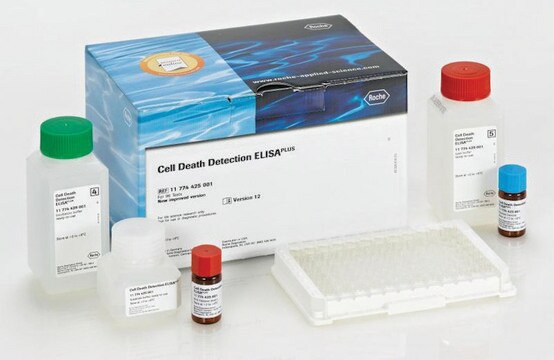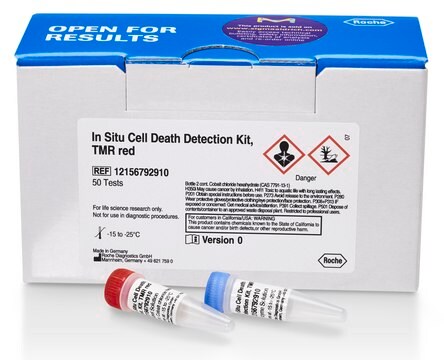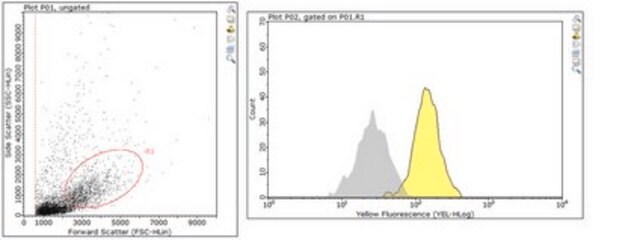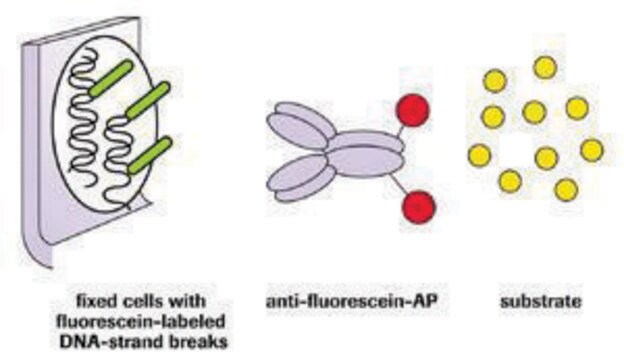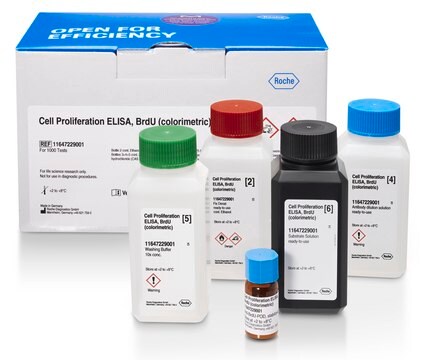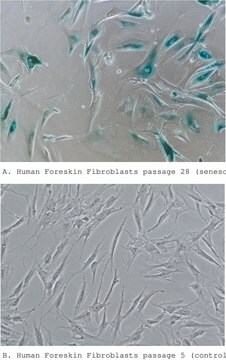推荐产品
一般說明
细胞死亡检测ELISA可用作光度酶免疫测定,体外定性和定量测定诱导细胞死亡后的细胞质组蛋白相关DNA片段(单核糖体和寡核糖体)。该测定基于定量夹心酶免疫测定原理,分别使用针对DNA和组蛋白的小鼠单克隆抗体。使用的抗体不具有物种特异性。
特異性
组蛋白抗体可与不同物种(如人、小鼠、大鼠、仓鼠、牛、负鼠和 非洲爪蟾)的组蛋白H1、H2A、H2B、H3和H4反应。DNA-POD抗体与ss-DNA和dsDNA结合。因此,ELISA可检测来自不同物种的单核小体和寡聚核小体,并且可用于检测许多不同细胞系统中的凋亡细胞死亡。
應用
仅供研究使用。不可用于诊断操作。
特异性测定细胞裂解物的细胞质组分中的单核小体和寡聚核小体。
特异性测定细胞裂解物的细胞质组分中的单核小体和寡聚核小体。
细胞死亡检测ELISA可以用于测量Caspase-3活性、细胞内活性氧(ROS)和细胞凋亡。
包裝
1个试剂盒包含9种组分。
準備報告
工作溶液:包被溶液
使用9 ml双蒸水预先稀释1 ml浓缩包被缓冲液。使用前,用9 ml包被缓冲液稀释1 ml组蛋白抗体(重悬液)。
洗涤液
将浓缩洗涤缓冲液预热至15至25°C,并取40 ml稀释于360 ml双蒸水中。充分混匀。
样品溶液
样品溶液的制备取决于所用的细胞系统和细胞死亡程度。
例如:将25 μl样品稀释于225 μl孵育缓冲液中。
偶联物溶液
将1 ml DNA-POD抗体(复溶液)稀释于9 ml孵育缓冲液中。
底物溶液
根据测试样品数量,将1、2或3片溶解于5、10或15 ml底物缓冲液中。
使用前,预热至15至25°C。
注:ABTS溶液在很长一段时间内是光敏感的。
储存条件(工作溶液):组蛋白抗体
在2至8°C保存2个月
DNA-POD抗体
在2至8°C保存2个月
包被溶液
临用前配制!
洗涤液
在2至8°C保存2个月
样品溶液
在2至8°C保存2个月
偶联物溶液
临用前配制!
底物溶液
在2至8°C保存1个月,避光保存。
使用9 ml双蒸水预先稀释1 ml浓缩包被缓冲液。使用前,用9 ml包被缓冲液稀释1 ml组蛋白抗体(重悬液)。
洗涤液
将浓缩洗涤缓冲液预热至15至25°C,并取40 ml稀释于360 ml双蒸水中。充分混匀。
样品溶液
样品溶液的制备取决于所用的细胞系统和细胞死亡程度。
例如:将25 μl样品稀释于225 μl孵育缓冲液中。
偶联物溶液
将1 ml DNA-POD抗体(复溶液)稀释于9 ml孵育缓冲液中。
底物溶液
根据测试样品数量,将1、2或3片溶解于5、10或15 ml底物缓冲液中。
使用前,预热至15至25°C。
注:ABTS溶液在很长一段时间内是光敏感的。
储存条件(工作溶液):组蛋白抗体
在2至8°C保存2个月
DNA-POD抗体
在2至8°C保存2个月
包被溶液
临用前配制!
洗涤液
在2至8°C保存2个月
样品溶液
在2至8°C保存2个月
偶联物溶液
临用前配制!
底物溶液
在2至8°C保存1个月,避光保存。
重構
组蛋白抗体
将冻干品重悬于1ml双蒸水中10分钟。充分混匀。
DNA-POD抗体
将冻干品重悬于1ml双蒸水中10分钟。。充分混匀。
将冻干品重悬于1ml双蒸水中10分钟。充分混匀。
DNA-POD抗体
将冻干品重悬于1ml双蒸水中10分钟。。充分混匀。
其他說明
仅用于生命科学研究。不可用于诊断。
仅试剂盒组分
产品编号
说明
- Anti-histone antibody (clone H11–4)
- Anti-DNA-POD antibody (clone MCA-33)
- Coating Buffer
- Washing Buffer
- Incubation Buffer, ready-to-use solution
- Substrate Buffer, ready-to-use solution
- ABTS Substrate Tablet
- Microplate Modules
- Adhesive Plate Cover Foils
查看所有结果 (9)
訊號詞
Danger
危險聲明
危險分類
Eye Dam. 1 - Skin Sens. 1
儲存類別代碼
12 - Non Combustible Liquids
水污染物質分類(WGK)
WGK 3
閃點(°F)
does not flash
閃點(°C)
does not flash
Gaya Hettiarachchi et al.
Molecular pharmaceutics, 13(3), 809-818 (2016-01-13)
Approximately, 40-70% of active pharmaceutical ingredients (API) are severely limited by their extremely poor aqueous solubility, and consequently, there is a high demand for excipients that can be used to formulate clinically relevant doses of these drug candidates. Here, proof-of-concept
Nilkantha Sen et al.
Nature cell biology, 10(7), 866-873 (2008-06-17)
Besides its role in glycolysis, glyceraldehyde-3-phosphate dehydrogenase (GAPDH) initiates a cell death cascade. Diverse apoptotic stimuli activate inducible nitric oxide synthase (iNOS) or neuronal NOS (nNOS), with the generated nitric oxide (NO) S-nitrosylating GAPDH, abolishing its catalytic activity and conferring
Silvia Di Loreto et al.
The international journal of biochemistry & cell biology, 40(2), 245-257 (2007-09-18)
The hippocampus is known to play a crucial role in learning and memory. Recent data from literature show that cognitive problems, common to aged or diabetic patients, may be related to accumulation of toxic alpha-oxoaldehydes such as methylglyoxal. Thus, it
Shikai Wang et al.
Scientific reports, 8(1), 17788-17788 (2018-12-14)
A growing number of studies have recently revealed a potential role for neutrophil extracellular traps (NETs) in the development of inflammation, coagulation and cell death. Deleterious consequences of NETs have been identified in ischemia-reperfusion (I/R)-induced organ damage, thrombosis and sepsis.
J P Heiserman et al.
Cell stress & chaperones, 20(3), 527-535 (2015-02-27)
Extracellular (ex) HSP60 is increasingly recognized as an agent of cell injury. Previously, we reported that low endotoxin exHSP60 causes cardiac myocyte apoptosis. Our findings supported a role for Toll-like receptor (TLR) 4 in HSP60 mediated apoptosis. To further investigate
我们的科学家团队拥有各种研究领域经验,包括生命科学、材料科学、化学合成、色谱、分析及许多其他领域.
联系技术服务部门